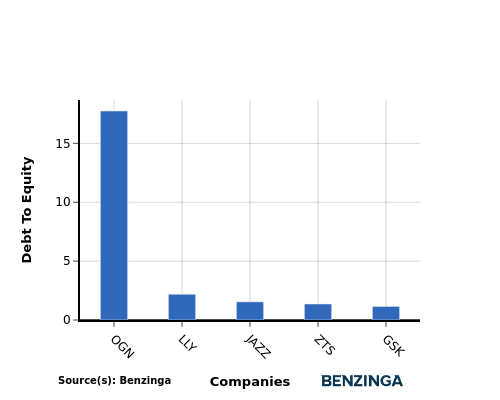In today’s rapidly changing and highly competitive business world, it is vital for investors and industry enthusiasts to carefully assess companies. In this article, we will perform a comprehensive industry comparison, evaluating Eli Lilly (NYSE:LLY) against its key competitors in the Pharmaceuticals industry. By analyzing important financial metrics, market position, and growth prospects, we aim to provide valuable insights for investors and shed light on company’s performance within the industry.
Eli Lilly Background
Eli Lilly is a drug firm with a focus on neuroscience, cardiometabolic, cancer, and immunology. Lilly’s key products include Verzenio for cancer; Mounjaro, Zepbound, Jardiance, Trulicity, Humalog, and Humulin for cardiometabolic; and Taltz and Olumiant for immunology.
| Company | P/E | P/B | P/S | ROE | EBITDA (in billions) | Gross Profit (in billions) | Revenue Growth |
|---|---|---|---|---|---|---|---|
| Eli Lilly and Co | 86.87 | 53.74 | 17.84 | 6.98% | $2.25 | $9.27 | 20.43% |
| Novo Nordisk AS | 37.48 | 29.76 | 13.06 | 18.97% | $35.74 | $57.79 | 25.34% |
| Johnson & Johnson | 26.16 | 5.43 | 4.38 | 3.8% | $5.38 | $15.51 | 5.25% |
| AstraZeneca PLC | 34.67 | 5.60 | 4.54 | 5.01% | $4.12 | $10.76 | 13.33% |
| Novartis AG | 19.29 | 5.10 | 4.54 | 7.5% | $5.61 | $9.94 | 8.93% |
| Zoetis Inc | 32.93 | 15.16 | 8.75 | 12.45% | $0.97 | $1.69 | 8.3% |
| GSK PLC | 23.51 | 4.16 | 1.88 | -0.41% | $1.17 | $5.62 | -1.66% |
| Takeda Pharmaceutical Co Ltd | 23.52 | 0.98 | 1.50 | 1.26% | $388.51 | $821.04 | 14.11% |
| Dr Reddy’s Laboratories Ltd | 18.68 | 3.52 | 3.60 | 4.84% | $21.72 | $46.34 | 13.87% |
| Jazz Pharmaceuticals PLC | 18.55 | 1.80 | 1.96 | 4.52% | $0.36 | $0.91 | 6.95% |
| Corcept Therapeutics Inc | 39.74 | 8.21 | 8.87 | 7.56% | $0.05 | $0.18 | 47.69% |
| Organon & Co | 3.35 | 8.84 | 0.68 | 112.72% | $0.4 | $0.92 | 4.15% |
| Prestige Consumer Healthcare Inc | 18.04 | 2.18 | 3.33 | 2.94% | $0.08 | $0.15 | -4.36% |
| Average | 24.66 | 7.56 | 4.76 | 15.1% | $38.68 | $80.9 | 11.83% |
table {
width: 100%;
border-collapse: collapse;
font-family: Arial, sans-serif;
font-size: 14px;
}
th, td {
padding: 8px;
text-align: left;
}
th {
background-color: #293a5a;
color: #fff;
text-align: left;
}
tr:nth-child(even) {
background-color: #f2f4f8;
}
tr:hover {
background-color: #e1e4ea;
}
td:nth-child(3), td:nth-child(5) {
text-align: left;
}
.dividend-amount {
font-weight: bold;
color: #0d6efd;
}
.dividend-frequency {
font-size: 12px;
color: #6c757d;
}
Through an analysis of Eli Lilly, we can infer the following trends:
- At 86.87, the stock’s Price to Earnings ratio significantly exceeds the industry average by 3.52x, suggesting a premium valuation relative to industry peers.
- With a Price to Book ratio of 53.74, which is 7.11x the industry average, Eli Lilly might be considered overvalued in terms of its book value, as it is trading at a higher multiple compared to its industry peers.
- With a relatively high Price to Sales ratio of 17.84, which is 3.75x the industry average, the stock might be considered overvalued based on sales performance.
- With a Return on Equity (ROE) of 6.98% that is 8.12% below the industry average, it appears that the company exhibits potential inefficiency in utilizing equity to generate profits.
- With lower Earnings Before Interest, Taxes, Depreciation, and Amortization (EBITDA) of $2.25 Billion, which is 0.06x below the industry average, the company may face lower profitability or financial challenges.
- With lower gross profit of $9.27 Billion, which indicates 0.11x below the industry average, the company may experience lower revenue after accounting for production costs.
- The company’s revenue growth of 20.43% is notably higher compared to the industry average of 11.83%, showcasing exceptional sales performance and strong demand for its products or services.
Debt To Equity Ratio

The debt-to-equity (D/E) ratio is a key indicator of a company’s financial health and its reliance on debt financing.
Considering the debt-to-equity ratio in industry comparisons allows for a concise evaluation of a company’s financial health and risk profile, aiding in informed decision-making.
In terms of the Debt-to-Equity ratio, Eli Lilly can be assessed by comparing it to its top 4 peers, resulting in the following observations:
- When evaluating the debt-to-equity ratio, Eli Lilly is in the middle position among its top 4 peers.
- The company maintains a moderate level of debt relative to its equity with a debt-to-equity ratio of 2.19, suggesting a relatively balanced financial structure.
Key Takeaways
For Eli Lilly in the Pharmaceuticals industry, the PE, PB, and PS ratios are all high compared to its peers, indicating overvaluation. The low ROE, EBITDA, and gross profit suggest lower profitability and operational efficiency relative to industry competitors. However, the high revenue growth rate may present a potential opportunity for Eli Lilly to improve its financial performance and competitive position in the future.
This article was generated by Benzinga’s automated content engine and reviewed by an editor.